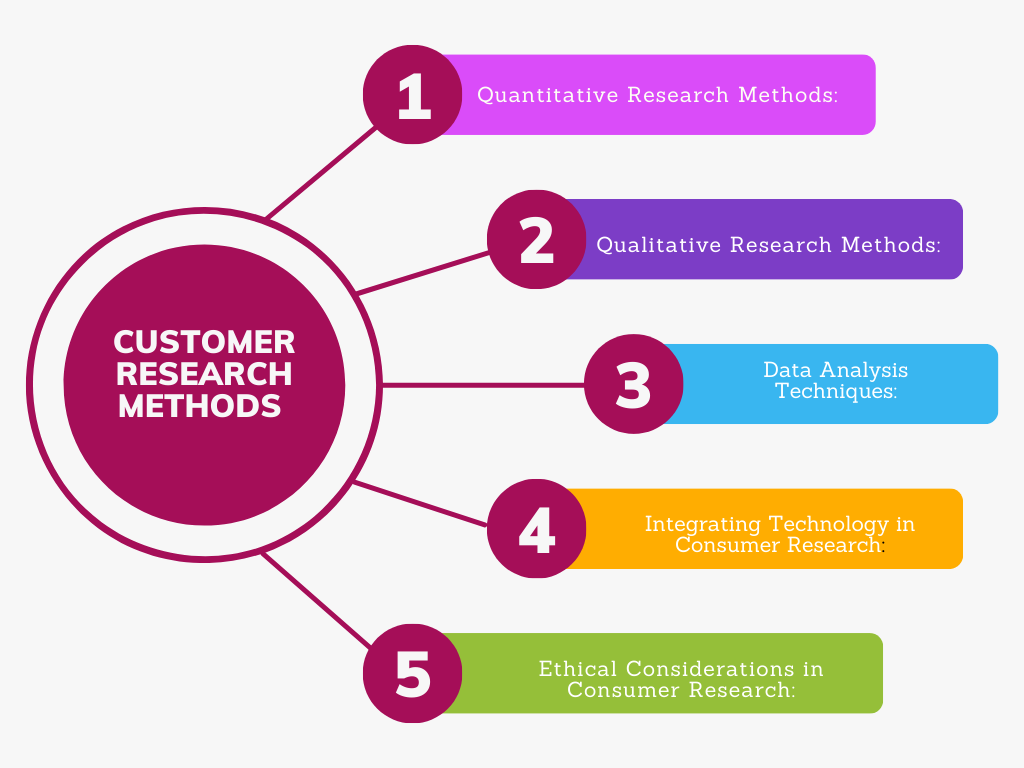Introduction
Consumer research is a pivotal aspect of modern business strategies. By understanding consumer behavior and preferences, companies can tailor their products and services to meet customer needs effectively. In this blog post, we will delve into various consumer research methods, providing insights and tips for each approach. Additionally, we’ve included a FAQ section to address common queries about consumer research.
Quantitative Research Methods:
1. Surveys and Questionnaires:
- Explanation of survey-based research.
- Tips for designing effective surveys.
- Online tools for creating surveys.
2. Observational Studies:
- Understanding the benefits of observing consumer behavior.
- Techniques for accurate observation.
- Real-world examples.
3. Experiments:
- Importance of controlled experiments in consumer research.
- Steps for conducting experiments.
- Common challenges and how to address them.
Qualitative Research Methods:
1. Focus Groups:
- Advantages of focus groups in capturing diverse opinions.
- Planning and facilitating successful focus groups.
- Analyzing focus group data.
2. In-depth Interviews:
- Exploring the depth of consumer insights through interviews.
- Crafting open-ended questions for rich responses.
- Interpreting interview data effectively
3. Ethnographic Research:
- Immerse into the world of consumers through ethnography.
- Blending in and understanding cultural context.
- Extracting valuable insights from ethnographic studies.

Data Analysis Techniques:
1. Descriptive Analysis:
- Summarizing and visualizing research data.
- Tools for descriptive data analysis.
- Creating meaningful reports.
2. Inferential Analysis:
- Making predictions and drawing conclusions from data.
- Introduction to statistical techniques.
- Common pitfalls to avoid.
3. Segmentation Analysis:
- Understanding the diversity within consumer groups.
- Techniques for effective segmentation.
Integrating Technology in Consumer Research:
1. Online Surveys and Digital Platforms:
- Benefits of online surveys.
- Choosing the right platform.
- Maximizing participation rates.
2. Social Media Analytics:
- Tapping into consumer sentiment on social media.
- Tools for social media analytics.
- Extracting actionable insights.
3. Eye-tracking and Biometric Measurements:
- Unveiling subconscious consumer reactions.
- Exploring eye-tracking technology.
- Ethical considerations with biometric data.
Ethical Considerations in Consumer Research:
- Respecting participant privacy and consent.
- Ensuring data security and confidentiality.
- Handling vulnerable populations with care.
FAQ
1. What is consumer research, and why is it important for businesses?
Consumer research involves studying the behavior, preferences, and needs of consumers to gain insights into their purchasing decisions. It helps businesses understand their target audience, refine products/services, and tailor marketing strategies to meet customer demands effectively.
2. How do I choose the right research method for my project?
The choice depends on your research objectives, available resources, and the nature of your target audience. Quantitative methods (surveys, experiments) are ideal for numerical data, while qualitative methods (focus groups, interviews) delve into deeper insights. Consider your research questions and the type of data you want to collect.
3. What ethical considerations should I keep in mind when conducting consumer research?
Respecting participants’ rights, ensuring informed consent, protecting their privacy, and maintaining confidentiality are crucial ethical considerations. Transparency in research purposes and avoiding harm to participants are also essential.
4. What role does technology play in modern consumer research?
Technology has revolutionized consumer research, offering online surveys, social media analytics, biometric measurements, and more. These tools provide real-time data, broader reach, and deeper insights into consumer behavior and preferences.
5. How can I transform research findings into actionable strategies?
Analyze the research data to identify patterns and trends. Use these insights to refine your products, tailor marketing campaigns, and enhance customer experiences. Create strategies that align with consumer preferences and address their pain points.
6. What are the benefits of quantitative research methods like surveys and questionnaires?
Surveys and questionnaires allow you to gather structured data from a large sample, making it easier to analyze trends, correlations, and general trends in consumer behavior. They provide statistical insights that guide decision-making.
Conclusion
Consumer research is the gateway to understanding the hearts and minds of your audience. Whether through quantitative methods that embrace numbers or qualitative techniques that delve into human stories, each approach enriches your knowledge and fuels your business strategy. By analyzing data meticulously, leveraging technology responsibly, and upholding ethical principles, you’re equipped to craft strategies that resonate with your consumers, fostering lasting connections and growth.
Also Read: What is Motivation in Consumer Behaviour: A Comprehensive Guide



